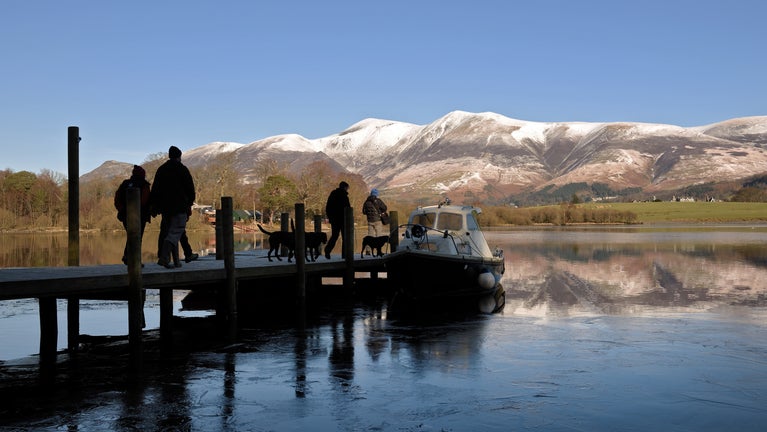
Discover more at Borrowdale and Derwent Water
Find out how to get to Borrowdale and Derwent Water, where to park, the things to see and do and more.

Take to the water with Derwent Water’s for a spot of canoeing, paddleboarding or paddling. Find out more about visiting St Herbert’s, Rampsholme and Derwent Island.
Learn to paddleboard, take the family canoeing or join a sailing session to get the best of Derwent Water views by joining one of our events. For more information and to book, click here.
You could give your legs a rest and catch one of the traditional wooden launches from the Keswick Launch company. Cruise to the end of the lake and walk back on the lakeshore path.
You can also get out on the water by hiring a canoe, kayak, stand-up paddle board, rowing boat or little motor boat from one of the outdoor providers around the lake at the foreshore, Lodore, Nichol End and Portinscale.
You can find activity providers here.
New Zealand pigmyweed is an alien invasive species. In Derwent Water it’s thriving so well it’s formed thick mats of vegetation across the lake bed, outcompeting the native species like water plantain which are on the Biodiversity Action Plan red list of species under threat. It's also covering up the spawning gravels for the UK’s rarest freshwater fish, the vendace, which only survives in Derwent Water and one other lake in England.
The worry is that it could spread to pristine lakes just a few miles over the fells like Buttermere, Crummock Water and Loweswater – especially as wild swimming becomes more popular.
Whenever you swim, paddle, paddleboard or sail in Derwent Water, please make sure you don’t take the weed with you when you go.
Checking, cleaning and drying your canoe, dinghy, wetsuit, swimming costume and dog all helps prevent the spread of invasive species.
Find out what you need to do here.

We care for all four islands in Derwent Water. You can land on two of them for a picnic but please remember that in order to protect their delicate eco-system, we do not allow camping, fires or bbqs on the Islands.
St Herbert’s is the largest of the islands, covering between four and five acres and named after the saint of the same name who brought Christianity to the area in 685 AD.
St Herbert used the island as a hermitage. After his death, it became a place of pilgrimage, and St Herbert's cell can still be identified amongst the undergrowth.
St Herbert's is also the inspiration for the fictional Owl Island in Beatrix Potter's 'The Tale of Squirrel Nutkin', so be sure to keep your eyes open for any little rafts pulled up along the shore.
Rampsholme gets its name from the wild garlic that thrives on the island. The word derives from the Old Norse 'Hrafns holmr' or 'wild garlic island'.
Rampsholme formed part of the late Earl of Derwent Water's confiscated estate, which was purchased by John Marshall Esq of Leeds in 1832.
Lord's Island is found in a quiet part of the lake. To protect the resident wildlife such as the nesting geese, please do not land here and respect a no-paddle zone between the main shoreline and the island.
However it is worth paddling past on the far side to see the primroses in the springtime.
Lord's Island was once the residence of the Earls of Derwent Water. A great house used to exist on the island dating from around 1460 with a drawbridge across to the mainland. The house is now gone but you can still make out its foundations.

Due to staff shortages, we will be unable to run open days at Derwent Island this year. We hope to once again be able to welcome visitors in 2026.
Derwent Island is the only inhabited island on the lake and, as a private residence, should only be admired from afar unless you’re booking on one of our open days.
It has been owned by monks and royalty and then to a group of German miners when they came to work in the area in the 16th century. They built a camp on the island, grew vegetables, kept animals and even brewed beer.
The current house was built by Joseph Pocklington in the 18th century, who was something of an eccentric. He also built a chapel and a small fort on the island, using the fort for mock battles during annual regattas on the lake.
From the 1950s the National Trust has cared for the island and its house which was considered by Wordsworth to be a blot on the landscape.
The house is lived in all year round but open to the public for five days every year, giving you the wonderful opportunity to travel to the island via canoe with experienced instructors. Visitors can then explore the house and garden and find out about island life past and present.
Watch this video for an insight into the open day, and visit the Visiting Derwent Island and House page for more information and updates on open day dates.

Find out how to get to Borrowdale and Derwent Water, where to park, the things to see and do and more.
Discover the internationally significant ‘Atlantic oakwoods’ and Derwent Water which support a variety of rare species of plants and animals, including the red squirrel and vendace.

There are nine National Trust car parks in Borrowdale and Derwent Water to choose from. Find out how to find them and how much parking costs.

Derwent Island and House is currently closed to visitors, but the site is still an interesting element of the Borrowdale landscape. Find out all you need to know about the history of the island and the many owners of the house.
